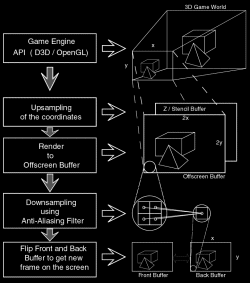This practical implementation achieves Ordered Grid Super-Sampling by up-sampling the scene by a factor of 2 (in the example), both horizontally and vertically. By increasing the horizontal and vertical resolution during the up-sampling, extra sample positions are introduced in an ordered grid shape.
Now the reason that super-sampling is commonly referred to as being done through software is because of the multiplication of the vertex positions, as this is generally done by the CPU. However, with NVIDIA, they are actually able to do this through hardware. As we mentioned, the T&L unit is used for this multiplication, so the operations never have to be sent to the CPU. If the T&L unit was not present, this could be considered a software method, but because of it, the anti-aliasing is actually a hardware feature.
In our example, we used an up-sampling rate of two in both the horizontal and the vertical direction. Nothing prevents an implementation where other up-sampling ratios are used, such as 3 or 4 or even more. The down-sampling where pixels are blended together to form the final on-screen anti-aliased pixel can be done in various ways. The example described simple 2-by-2 pixel averaging, but there is no rule that specifies that such a simplistic filter has to be used. More advanced, higher-order filters also can be used.

